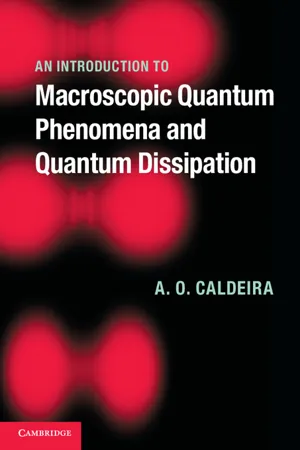
- English
- PDF
- Available on iOS & Android
An Introduction to Macroscopic Quantum Phenomena and Quantum Dissipation
About this book
Reviewing macroscopic quantum phenomena and quantum dissipation, from the phenomenology of magnetism and superconductivity to the presentation of alternative models for quantum dissipation, this book develops the basic material necessary to understand the quantum dynamics of macroscopic variables. Macroscopic quantum phenomena are presented through several examples in magnetism and superconductivity, developed from general phenomenological approaches to each area. Dissipation naturally plays an important role in these phenomena, and therefore semi-empirical models for quantum dissipation are introduced and applied to the study of a few important quantum mechanical effects. The book also discusses the relevance of macroscopic quantum phenomena to the control of meso- or nanoscopic devices, particularly those with potential applications in quantum computation or quantum information. It is ideal for graduate students and researchers.
Frequently asked questions
- Essential is ideal for learners and professionals who enjoy exploring a wide range of subjects. Access the Essential Library with 800,000+ trusted titles and best-sellers across business, personal growth, and the humanities. Includes unlimited reading time and Standard Read Aloud voice.
- Complete: Perfect for advanced learners and researchers needing full, unrestricted access. Unlock 1.4M+ books across hundreds of subjects, including academic and specialized titles. The Complete Plan also includes advanced features like Premium Read Aloud and Research Assistant.
Please note we cannot support devices running on iOS 13 and Android 7 or earlier. Learn more about using the app.
Information
Table of contents
- Cover
- Half-title page
- Title page
- Copyright page
- Dedication
- Contents
- Preface
- Acknowledgments
- 1 Introduction
- 2 Elements of magnetism
- 3 Elements of superconductivity
- 4 Brownian motion
- 5 Models for quantum dissipation
- 6 Implementation of the propagator approach
- 7 The damped harmonic oscillator
- 8 Dissipative quantum tunneling
- 9 Dissipative coherent tunneling
- 10 Outlook
- Appendix A Path integrals, the quantum mechanical propagator, and density operators
- Appendix B The Markovian master equation
- Appendix C Coherent-state representation
- Appendix D Euclidean methods
- References
- Index